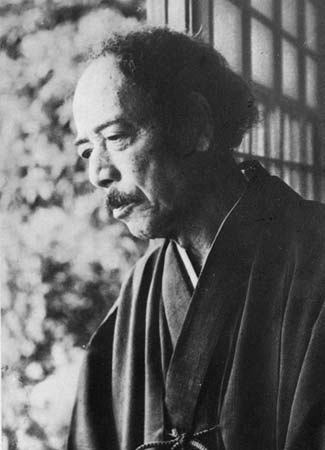Yokoyama Taikan
Japanese painter
original name Sakai Hidemaro
born Nov. 2, 1868, Mito, Japan
died Feb. 26, 1958, Tokyo
 Japanese painter who, with his friend Hishida Shunsō, contributed to the revitalization of traditional Japanese painting in the modern era.
Japanese painter who, with his friend Hishida Shunsō, contributed to the revitalization of traditional Japanese painting in the modern era.Yokoyama studied Japanese painting with Hashimoto Gahō at the Tokyo Art School and became a favourite of its principal, Okakura Kakuzō (Tenshin). Yokoyama started teaching design at the school in 1896 but left when the principal was ousted. When the latter started the Japan Fine Arts Academy with Hishida, Shimomura Kanzan, and others, Yokoyama also joined him, in 1898. He tried to reconsider the whole technique of traditional Japanese painting, which relied heavily on line drawing, and with Hishida developed a new style, eliminating lines and concentrating on colour combinations. This style was pejoratively nicknamed mßrßtai (mōrō means “vague,” or “indistinct,” but at that time had a stronger negative sense; mōrō shafu, for example, meant “hooligan rickshaw man”).
Yokoyama became one of the examiners for the Fine Arts Exhibition sponsored by the Ministry of Education (founded in 1907; the exhibition was abbreviated as Bunten). Internal squabbling subsequently resulted in his being ousted from this post, and he concentrated on reviving the Japan Fine Arts Academy, which had closed down upon Okakura Kakuzō's death. The Academy was revived in 1914, and its annual exhibitions, which have the abbreviated name Inten, became an important, nongovernmental outlet for young talents. Among Yokoyama's works are “Mountain Path,” “Vicissitudes,” and “Cherry Blossoms.”
- legacy
- legal aid
- legal education
- legal ethics
- legal fiction
- legal glossator
- Legalism
- Le Gallienne, Eva
- legal maxim
- legal profession
- Legal Tender Cases
- Legaré, Hugh Swinton
- Legaspi
- legate
- legation
- Legazpi, Miguel López de
- legend
- Legendre, Adrien-Marie
- Leggett, Anthony J.
- Legg–Calvé–Perthes syndrome
- legion
- Legionnaire disease
- Legion of Honour
- Legion of Merit
- legislative apportionment